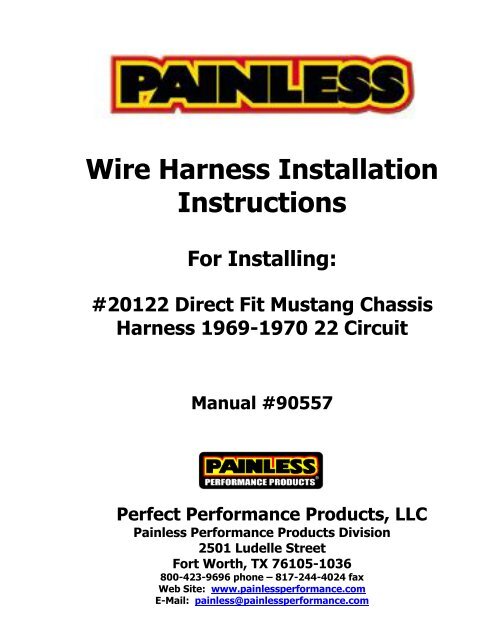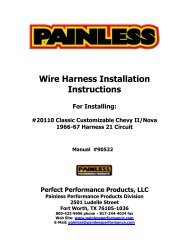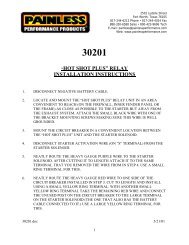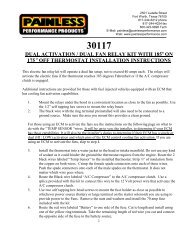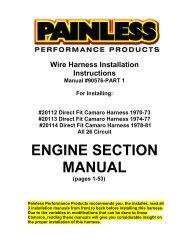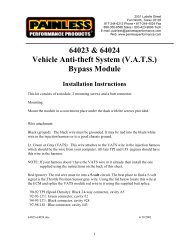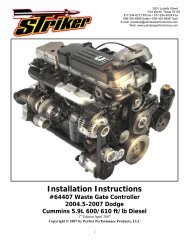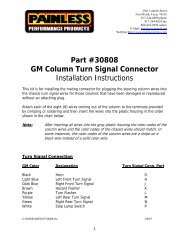Wire Harness Installation Instructions - Painless Wiring
Wire Harness Installation Instructions - Painless Wiring
Wire Harness Installation Instructions - Painless Wiring
Create successful ePaper yourself
Turn your PDF publications into a flip-book with our unique Google optimized e-Paper software.
<strong>Wire</strong> <strong>Harness</strong> <strong>Installation</strong><strong>Instructions</strong>For Installing:#20122 Direct Fit Mustang Chassis<strong>Harness</strong> 1969-1970 22 CircuitManual #90557Perfect Performance Products, LLC<strong>Painless</strong> Performance Products Division2501 Ludelle StreetFort Worth, TX 76105-1036800-423-9696 phone – 817-244-4024 faxWeb Site: www.painlessperformance.comE-Mail: painless@painlessperformance.com
If you have any questions concerning the installation of thisharness or having trouble in general, feel free to call <strong>Painless</strong>Performance Products' tech line at 1-800-423-9696. Calls areanswered from 8am to 5pm central time, Monday thru Friday,except holidays.We have attempted to provide you with as accurateinstructions as possible, and are always concerned aboutcorrections or improvements that can be made. If you havefound any errors or omissions, or if you simply have commentsor suggestions concerning these instructions, please write usat the address on the cover and let us know about them. Or,better yet, send us a fax at (817) 244-4024 or e-mail us atpainless@painlessperformance.com. We sincerely appreciateyour business.Perfect Performance Products, LLC shall in no event be liable in contract ortort (including negligence) for special, indirect, incidental, or consequentialdamages, such as but not limited to, loss of property damage, or any otherdamages, costs or expenses which might be claimed as the result of the use orfailure of the goods sold hereby, except only the cost of repair or replacement.90557 <strong>Installation</strong> ManualJanuary 15, 2014Copyright 2007 by Perfect Performance Products, LLC2
NOTE :If your vehicle has an existing harness, you will want to retain it for the possiblere-use of various Pigtails & Connector housings, particular to your application.Included in this kit is a sheet of pre-printed labels to assist in identifyingconnections as the existing harness is removed from the vehicleIf you do not have an existing harness, there is a package of terminals includedwith the harness that will enable you to make most of the connections needed.Replacement lighting pigtails & sockets can be readily obtained from your localparts distributor3
TABLE OF CONTENTS1.0 Introduction2.0 About These <strong>Instructions</strong>…………………………………………………………………..……………………………..43.0 Contents in The <strong>Painless</strong> <strong>Wire</strong> <strong>Harness</strong> Kit………………………………………………………………………….54.0 Tools Needed…………………………………………………………………………………………………………………..55.0 Pre-<strong>Installation</strong> and <strong>Harness</strong> Routing Guidelines………….………………………………………………………76.0 <strong>Harness</strong> <strong>Installation</strong> <strong>Instructions</strong>………………………………………………………………………………………..76.1 General <strong>Installation</strong>6.2 <strong>Harness</strong> Attachment6.3 Grounding The Automobile6.4 Terminal <strong>Installation</strong> and Making Connections6.5 Testing The System7.0 Specific Circuit Connections……………………………………………………………………………………………….167.1 Alternator/Regulator/Solenoid7.2 High Amperage Alternator Kit7.3 Engine Section7.4 Headlight Section7.5 Rear Light Section7.6 Interior Lighting7.7 Dimmer Switch7.8 Headlight Switch7.9 Turn Signal Switch and Brake Light Switch7.10 Gauge Cluster Section7.11 Ignition Switch7.12 Wiper Switch/ Wiper Motor7.13 Interior Ground7.14 Console7.15 Heater-A/C Components7.16 Radio7.17 Glove Compartment7.18 Accessory Relay8.0 <strong>Wire</strong> Connection Index and Fuse Requirements……………………………………………………………………33LIST OF TABLESTable 8.1 Fuse Requirements………………………………………………………………………………………………..36Table 8.2 <strong>Wire</strong> Connection Index (1 of 6)…………………………………………………………………..………….36Table 8.2 <strong>Wire</strong> Connection Index (2 of 6)……………………………………………………………………..……… 37Table 8.2 <strong>Wire</strong> Connection Index (3 of 6)……………………………………………………………………………...38Table 8.2 <strong>Wire</strong> Connection Index (4 of 6)……………………………………………………………………………...39Table 8.2 <strong>Wire</strong> Connection Index (5 of 6)……………………………………………………………………………...40Table 8.2 <strong>Wire</strong> Connection Index (6 of 6)…………………………………………………………..………………….41Table 8.2 <strong>Wire</strong> Connection Index (6 of 6)…………………………………………………………..………………….42<strong>Painless</strong> Performance Products recommends you, the consumer, read thisinstallation manual from front to back before installing this harness. Due to thevariables in modifications done to these classic 1969 and 1970 Mustangs, readingthis manual will give you considerable insight on the proper installation of thisharness in an original or modified application.4
1.0 INTRODUCTIONYou have purchased what we at <strong>Painless</strong> Performance Products believe to be the most up-to-date andeasiest-to-install automotive wire harness on the market. It is designed for easy installation, even if youhave no electrical experienceAll Kits have a built-in-anti-theft feature. Removing the fuse labeled “coil” from the fuse block will preventthe vehicle from starting.The proper fuses have been pre-installed in the fuse block. In addition, all wires are color-coded andmarked for easy identification. This will help you identify the different circuits during installation and lateron if additions to the overall system are necessary. For fuse specifications and wire color designations,see Section 8.1 and Table 8.1.This <strong>Painless</strong> wire harness is designed to be used in 1969 - 1970 Ford Mustangs. All wire is 600 volt,257F, TXL. Standard automotive wire is GPT, 300 volt, 176F, with PVC insulation.This complete Classic Mustang wiring system has been designed with four major sections incorporatedinto it:ENGINE SECTION: Water temperature, oil pressure, aftermarket tachometer, coil, choke, a/ccompressor clutch, coil, wiper motor, ignition bypass (for ballast resistor), reverse switch and neutralsafety switchHEADLIGHT SECTION: Includes high beam, low beam, park lights, marker lights right turn, left turn,horns, voltage regulator, starter solenoid, washer pump, brake warning, battery feed and alternator.UNDER-DASH and INTERIOR SECTION: Includes wires to connect heater-a/c switch, headlightswitch, turn signal switch, radio, tachometer (factory and aftermarket), ignition switch, cigar lighter,dimmer switch, brake switch, a/c blower motor, wiper switch, gauges and indicator lights, right and leftdoor jam switches, shift indicator light, courtesy lights, clock, and glove box.REAR LIGHT SECTION: Includes dome light, taillights, stoplights, left and right turn signals, markerlights trunk light, backup lights, license plate light, and fuel sending unit.Note: Be sure to retain Convertible Power Top wiring, Cruise Control wiring,Sport Lamp wiring, and Tilt Wheel wiring when removing the old harness.Circuits for these accessories are NOT included in this harness.2.0 ABOUT THESE INSTRUCTIONSThe contents of these instructions are divided into major Sections, as follows:1.0 Introduction2.0 About These <strong>Instructions</strong>3.0 Contents of <strong>Painless</strong> <strong>Wire</strong> <strong>Harness</strong> Kit4.0 Tools Needed5.0 Pre-<strong>Installation</strong> and <strong>Harness</strong> Routing Guidelines6.0 <strong>Harness</strong> <strong>Installation</strong> <strong>Instructions</strong>7.0 Specific Circuit Connections8.0 <strong>Wire</strong> Connection Index and Fuse RequirementsSections are divided into subsections and Paragraphs. Throughout these instructions, the Figurenumbers refer to illustrations and the Table numbers refer to information in table form. These are5
located in Sections or Paragraphs corresponding to the number. Always pay special and careful attentionto any Notes, especially those in the Tables, and any text marked Caution.3.0 CONTENTS OF THE PAINLESS WIRE HARNESS KITRefer to the list below to take inventory of all the parts in the kit. If anything is found tobe missing, contact the dealer the kit was purchased from or <strong>Painless</strong> Performance at(800)423-9696. The 1969/1970 Mustang <strong>Wire</strong> <strong>Harness</strong> Kit should contain the followingitems:The Main <strong>Wire</strong> <strong>Harness</strong>, with Fuse Block, pre-wired fuses and relays installed.Bag Kit: 1 pkg. of small and 1 pkg. of large Nylon Tie Wraps, Ballast Resistor,Maxi Fuse, 2 Firewall Grommets, Aluminum Plate, and a Fuse IdentificationLabel.Fuse block base and coverParts Box containing Terminals, Splices, Spare Fuses etc.Figure 3-1 <strong>Painless</strong> <strong>Wire</strong> <strong>Harness</strong> Kit4.0 TOOLS NEEDEDIn addition to basic hand tools the following will also be needed: Crimping Tool Note: Use a quality tool to avoid over-crimping. <strong>Wire</strong> Stripper Test Light or Volt Meter Small (10 amp or less) Battery Charger6
5.0 PRE-INSTALLATION AND HARNESS ROUTING GUIDELINES<strong>Installation</strong> of this wire harness consists mainly of two parts: The physical routing and securing of the wire harness. The connection of the individual circuits to their components.These two major tasks are not separate steps, but are integrated together. In otherwords, you will route a section of wires and make that sections connections. Route thenext section of wires and make those sections connections. The layout of this 1969-1970 Mustang harness will dictate how to physically route the harness in yourautomobile. The breakouts and connections are very close to the original Fordharnesses and should fit just as well if not better. It’s a good idea to document how theoriginal harness was routed as this new one follows most of the same routing. Thefitment greatly depends on to what extent you want to secure and conceal the harness.<strong>Painless</strong> offers some general guidelines and routing practices starting in Section 5.2,GENERAL installation instructions in Section 6.0, and precise instructions concerningthe electrical connections you will make in Section 7.0. To help you begin thinkingthrough the installation of your wire harness please read the following sections:5.1 Familiarize yourself with the harness by removing the harness from the box,laying it out on a table or on the floor and locating each of the harness sections.Whenever a particular harness section is referred to in these instructions it isshown in "all caps": ENGINE SECTION.5.2 It is recommended to route the harness through and around open areas insidethe car. Inside edges provide protection from hazards and also provide places fortie wraps, clips, and other support.5.3 Route the harness away from sharp edges, exhaust pipes, hood, trunk and doorhinges.5.4 Plan where harness supports will be located. Allow enough slack at places wheremovement could occur (body to frame, frame to engine, etc.)5.5 At wire ends, don't depend on the terminals to support the harness. The weightof the harness could cause terminals to disconnect or copper wire strands tobreak.5.6 The wires should be bundled into groups. Use nylon ties, poly split loom, or tape.6.0 HARNESS INSTALLATION INSTRUCTIONS6.1 General <strong>Installation</strong>CAUTION: DISCONNECT THE POWER FROM YOUR VEHICLE BYREMOVING THE NEGATIVE (BLACK) BATTERY CABLE FROM THEBATTERY.6.1.1 Mount the base to the left of the stock fuse block location with two of the selftapping screws from the parts kit. See Figure 6-1.6.1.2 Try to position the base over the seam/indention in the fire wall, to the left ofthe 3 spot welds. This will ensure the screws used to mount the fuse blockbase will not be visible in the engine compartment. See Figure 6-27
Figure 6-1 Fuse Block Base8
Figure 6-2 Fuse Block Base LocationFigure 6-3 Routing Fuse Block through Instrument Cluster Opening6.1.2 Route the fuse block and attached harness through the instrument clusteropening and snap it into the fuse block base with the relays closest to thewindshield. See Figure 6-3 and Figure 6-4. (Note: The fuse block doesnot need to be grounded.)9
Figure 6-4 Fuse Block Snapped Into Base6.1.3 Pull all the wires located in the HEADLIGHT SECTION and the TAIL SECTIONdown through the gauge cluster opening. It is easier to pull these wires downthan it is to feed all the interior wires up through the opening.6.1.4 Locate the aluminum plate included with the parts kit. This plate is used tocover the factory hole the bulk head connector once used. Install the largergrommet included with this kit into the hole on the plate. With the grommetinstalled, it is easier to center the plate over the hole left in the fire wall.Using 4 screws included with this kit install the plate over the existing hole inthe fire wall. See Figure 6-510
Figure 6-5 Firewall Plate6.1.5 Once the plate is installed, remove the grommet. Starting with the VoltageRegulator connector, feed the HEADLIGHT SECTION through the plate intothe engine compartment. Now with the headlight section pulled through theplate, the grommet will need to be cut to fit around the wires. Split thegrommet on one side; do not cut the grommet in half. See Figure 6-6With the grommet cut, install it around the wire and into the plate. It will bea tight fit.Figure 6-6 Grommet Split6.1.6 Route the HEADLIGHT SECTION following the same path the factory harnesstook. Run the harness long the driver’s side inner fender and shock tower,down to the hole at the bottom of the core support, through the coresupport, and along the bottom of the support over to the passenger side, andfeed the Voltage Regulator, Starter Solenoid, and Alternator wires through11
the bottom of the core support on the passenger side back into the enginecompartment. See Figures 6-7 A,B,CFigure 6-7A Headlight Section RoutingFigure 6-7B Headlight Section RoutingFigure 6-7C Headlight Section Routing6.1.7 Now locate the TAIL SECTION. This section of the harness will be routeddown the side of the fuse block, to the left of the dimmer switch, *under thecarpet next to the door sill*, under the rear seat area, over the driver’s sidequarter panel wheel well and into the trunk. There are 2 wires in this sectionthat need to remain in the interior of the car, wires labeled “C Pillar Light B+#989” and “C Pillar Light Ground”. Once in the trunk, route the wire down the12
side of the rear quarter panel, under the drivers’ side tail light housing,between the rear panel and the gas filler neck, over to the passengers’ side.See Figures 6-8 A,B,& C*The tail light section does not follow the exact factory routing. The factory routing had theTail Section wires running through the kick panel area and into the door sill channel. Thisrouting has been changed due to the light sockets installed on the <strong>Painless</strong> harness. They willnot fit into the openings at either end of the door sill channel.Figure 6-8A Tail Section RoutingFigure 6-8B Tail Section Routing13
Figure 6-8C Tail Section RoutingFigure 6-8D Tail Section Routing6.1.8 The final sections of the harness to be routed are the ENGINE SECTIONand INTERIOR SECTION. The INTERIOR SECTION must be routed towardsthe passenger side of the car, behind the bracing of the dash (See Figure 6-9) in order to get the ENGINE SECTION over to where it needs to be. TheENGINE SECTION of the harness is to be fed through the hole in the firewallunder where the shock tower brace meets the firewall. You can install thegrommet now or wait until the wires are pulled through the hole, then slidethe grommet over the wires and into the hole. Running a string or a wirethrough the hole from the engine compartment into the interior may be theeasiest way to get everything through the hole. (See Figure 6-10) Tape theENGINE SECTION to the string/wire then pull the wire out into the enginecompartment. After this section has been pulled through; carefully install thesmaller grommet from the parts kit into the hole if you have not already doneso. See Figure 6-11Figure 6-9 Interior Section RoutingFigure 6-10 Engine Section Routing14
6.2 <strong>Harness</strong> AttachmentFigure 6-11 Engine Section<strong>Harness</strong> routing and shaping is and should be a time-consumingtask. Taking your time will enhance the beauty of your installation.Please be patient and TAKE YOUR TIME!6.2.1 Mold the harness to contour the firewall, fenders, core support or any otherareas where wires or harness sections are routed. Remember to route theharness away from sharp edges, exhaust pipes, hood, trunk, and doorhinges.6.2.2 Attach harness groups to your automobile with clips or zip ties starting at thefuse block and working you way towards the outer harness circuits. The dashwires should be routed out of the way of any under-dash obstacles, such asvent levers, air conditioning controls, radio, etc.Note: Do not tighten tie wraps and mounting devices until eachindividual connection has been made on the particular circuit to bewire tied. Make all harness attachments LOOSELY, until all connectionsare made in each section.6.2.3 When using wire loom on the visible areas of the harness, it will need to bewire tied every 12" or so. This will make a very attractive assembly. Underthe dash a tie installed every 6" or so will hold the wires in place nicely.Remember to take your time.6.3 Grounding the AutomobileThis <strong>Painless</strong> <strong>Wire</strong> <strong>Harness</strong> Kit includes the following ground wires: one frontground, one tail ground, one built-in ground wire for the horn, one groundwire for the interior and a ground wire for the accessory relay. Making theseground connections will be more thoroughly covered in the specificconnection section. Also, ground wires in this kit differ from those used byFord for the 1969 and 1970 Mustangs. All BLK/WHT wires in this kit are15
ground wires. Any additional circuits or accessories requiring a ground willhave to be added.6.3.1 Connect a Ground Strap or Cable (even a 10-gauge wire is too small) fromthe Negative Battery terminal to the automobile frame.6.3.2 Connect a Ground Strap from the Engine to the frame. DO NOT RELYUPON THE MOTOR MOUNTS TO MAKE THIS CONNECTION.6.3.3 Connect a Ground Strap from the Engine to the Body.6.4 Terminal <strong>Installation</strong> and Making ConnectionsNote: In the following steps you will be making the circuit connections. Beforeyou start, you should carefully read Sections 7.0, as appropriate, and refer toSection 8.0 as needed, DOUBLE-CHECKING your routing and length calculationsbefore cutting any wires and making connections. The majority of the harnesshas been pre-terminated.6.4.1 Have all needed tools and connectors handy.6.4.2 Select the correct size terminal for the wire application.6.4.3 Determine the correct wire length and cut the wire. Remember to allowenough slack in the harness and wires at places where movement couldpossibly occur, such as automobile body to frame, frame to engine, etc.Double-check your calculations.6.4.4 Strip the insulation from the wire. Strip only enough necessary for the type ofterminal you are using. All of the terminals included in this kit require a ¼”strip length.6.4.5 Insert the stripped portion of the wire into the crimp side of the terminal. Becareful as to not allow the individual wire strands to fray during insertion.6.4.6 Crimp the terminal onto the wire using the proper jaw location on thecrimpers.Note: In step 6.4.6 be sure to use the proper jaw location on your crimpers.Most crimping tools have it color coded for which cavity to use. 18-22ga – Red,16-14ga – Blue, and 12-10ga – Yellow. CAUTION: DO NOT OVER-CRIMP!6.4.7 Many connections will be made throughout the installation process. Makesure each wire is FIRST properly routed and THEN attach. DO NOT ATTACHFIRST AND ROUTE AFTERWARD.6.4.8 After all wires are terminated and securely attached, tighten the mountsand/or zip ties to secure the harness permanently.6.5 Testing The SystemCAUTION: IF YOU HAVE NOT YET DISCONNECTED THE BATTERYFROM THE AUTOMOBILE, DO SO NOW! DO NOT CONNECT THEBATTERY CHARGER WITH THE BATTERY CONNECTED.6.5.1 Use a small (10 amp or less) battery charger to power up the vehicle for thefirst time to test the circuits. If there is a problem anywhere, the batterycharger's low amperage and internal circuit breaker will provide circuitprotection.16
6.5.2 Connect the battery charger's NEGATIVE cable to the automobile chassis orengine block and its POSITIVE cable to the automobile's positive batteryterminal lug.6.5.3 INDIVIDUALLY turn on each light, ignition, wiper circuit, etc. and check forproper operation.Note: The turn signals will not flash properly if you do not have both the frontand rear bulbs installed and connected.6.5.4 After all circuits have been checked, disconnect the battery charger andattach the vehicles battery cables to the battery. REPEAT STEP 6.5.3.7.0 SPECIFIC CIRCUIT CONNECTIONS7.1.1 Alternator/Regulator/Solenoid7.1.2 Connect HEADLIGHT SECTION wire #915 (BLK/YLW) to the AlternatorOutput post marked “Bat” or “B+”. See Figure 7-27.1.3 Connect HEADLIGHT SECTION wire #914 (ORG) to the Alternator postmarked “FLD”.7.1.4 Locate the Voltage Regulator Connector in the HEADLIGHT SECTION andplug it in to the Voltage Regulator, which is on the passenger side innerfender, under the starter solenoid.7.1.5 Connect the yellow wire with the preinstalled female bullet connector tothe Noise Capacitor. See Figure 7-27.1.6 Connect the Regulator Ground <strong>Wire</strong> (BLK/WHT) to one of the boltsholding the regulator in place.7.1.7 Locate the Maxi Fuse Base in the parts kit and attach it to the passengerside shock tower. See Figure 7-37.1.8 Connect HEADLIGHT SECTION wire #916 to one side of Maxi Fuse Base.Using the remaining portion of wire #916 connect the other side of theMaxi Fuse Base to the B+ side of the starter solenoid. See Figure 7-47.1.9 Connect HEADLIGHT SECTION wire #919 to the “S” terminal on thestarter solenoid. See Figure 7-57.1.10 If you are using a Ballast Resistor, connect HEAD LIGHT SECTION wire#970 (BRN) to the “I” terminal on the starter solenoid. See Figure 7-5,also See 7.3.317
Figure 7-1 Alternator/Regulator ConnectionsFigure 7-2 Regulator ConnectionsFigure 7-3 Maxi Fuse Base Mounting18
Figure 7-4 <strong>Wire</strong> #916 Connections7.2 High Amperage Alternator Kit7.2.1 If an alternator with an output of more than 65 amps is being installed, a<strong>Painless</strong> High Amperage Alternator Kit, <strong>Painless</strong> P/N 30709, will need to bepurchased.7.3 Engine Section See Figure 7-5.7.3.1 If using an aftermarket tachometer, connect ENGINE SECTION wire #923(RED/YLW) to the negative side of the ignition coil.7.3.2 Connect ENGINE SECTION wire #920 (RED/GRN) to one side of the ballastresistor. Connect the other side of the ballast resistor to the positive post onthe ignition coil. Note: If using a ballast resistor be sure to mount it awayfrom other wiring and hoses. It gets very hot during operation.7.3.3 ENGINE SECTION wire #970 (BRN) is used both on a point’s type ignitionsystem and a Duraspark II System. It is to be connected directly to thepositive post on the ignition coil or the coil feed side on the ballast resistor.The other end, located in the HEADLIGHT SECTION, is to be connected to the“I” terminal on the starter solenoid. See7.1.8 also See Figure 7-5.19
Figure 7-5 Points Type Ignition Diagram7.3.4 Connect ENGINE SECTION Temperature Sending Unit wire #921 (RED/WHT)to the engine temperature sending unit. Connect ENGINE SECTION OilPressure Sending Unit wire #922 (WHT/RED) to the engine oil pressuresending unit. Small ring terminals and nuts have been supplied in the partskit to make these connections.7.3.5 Connect the ENGINE SECTION Electric Choke B+ wire #954 (RED) to theelectric choke.Figure 7-6 Ford Duraspark II Systems (Ford Electronic Ignition)7.3.6 Neutral Safety/Backup Light Switch wire #’s 958, 956 and #919 (2 wires) allbreakout from the firewall in the ENGINE SECTION. #958 (BLK/RED) is thepower source to the switch for the backup lights and #956 (BLK/RED) is thewire connected to the actual bulbs. <strong>Wire</strong> IGNITION SWITCH START #919(RED/BLU) comes from the start terminal on the Ignition Switch and providesthe start signal to the Neutral Safety switch. <strong>Wire</strong> STARTER SOLENOID #91920
(RED/BLU) carries the start signal from the Neutral Safety switch to the StarterSolenoid. See Figure 7-7.Figure 7-7 NEUTRAL SAFETY SWITCH7.4 Headlight Section7.4.1 Locate the 2 wires labeled Brake Warning #968 (PUR). These 2 wires will belocated close to the aluminum fire wall plate you installed earlier. Using splicessupplied with this kit, splice the original factory brake warning switch connectoronto these 2 wires, it makes no difference which PUR wire goes where. Now withthe connector installed on the new harness, plug the connector into the brakewarning switch. See figure 7-87.4.2 Following the HEADLIGHT SECTION towards the front of the car, you will find 2wires next to the core support. These wires are labeled Washer B+ #983 (GRN)and Washer Pump Ground (BLK/WHT). Using splices supplied with this kit, splicethe original factory washer pump connector onto these 2 wires, matching thefactory wire colors to the new. Now with the connector installed on the newharness, plug the connector into the washer pump. See figure 7-97.4.3 Install the driver’s side marker light connector into its housing on the lower fender.Make certain that a bulb is installed to avoid having to take the connector back outto install one.7.4.4 The next group of wires will be for the Left Turn Signal and Park Lamp. Usingbullet connectors included with the parts kit, match the colors and connect thefollowing wires onto the factory molded connector: Left Turn Signal #926(GRN/WHT), Park lights #927 (BLK/YLW), Left Turn/Park Ground (BLK/WHT)21
Figure 7-8 Brake Warning ConnectorFigure 7-9 Washer Pump Connector7.4.5 Locate the connector for the Left Headlamp. It is the black connector with 3 wires:“High Beam #908” (GRN/BLK), “Low Beam #909” (RED/BLK), “Left HeadlampGround” (BLK/WHT). Plug this connector into the back of the headlamp. Makecertain that the connector is going on straight; the tabs on the back of theheadlamp have a tendency to bend. See Figure 7-117.4.6 The other black connector with 2 wires, “High Beam #908” (GRN/BLK) and “LeftHigh Beam Ground” (BLK/WHT), is for the 1969 models. This connector plugs intothe separate high beam located in the grille; use the same caution as theheadlamp connector. For the 1970 models this connector can be cut off and thewires tied or taped into the harness. See Figure 7-117.4.7 “Horn B+ #924” needs to be routed and connected to the driver’s side horn.7.4.8 All BLK/WHT ground wires located in the HEADLIGHT section share the sameground wire. This is a 4’ wire labeled “Front Ground” located close to the center ofthe core support. Using a ring terminal, connect this wire to a good clean ground.One of the bolts on the center grill support makes for a good ground. See Figure7-107.4.9 Repeat all of the above steps to the components located on the passenger’s side.7.4.10Figure 7-10 Front Ground Connection22
Figure 7-11 Headlight Section Connections7.5 Rear Light Section7.5.1 The REAR LIGHT SECTION consists of: Taillights, Stoplights, Left and RightTurn Signals, Trunk Light, Backup Lights, License Plate Light, Dome Light, aGround wire and Fuel Sending Unit.Figure 7-10 Rear Light Section and Dome Light23
7.5.2 Locate the factory lead coming from the dome light in the upper left side ofthe trunk. Connect the wire labeled “To Dome Light #945” (BLK/BLU) to thislead. If no lead exists, route wire #945 to the dome light.7.5.3 Trunk Light B+ #946 needs to be connected to the truck light switch onmodels equipped with this feature. A power wire from the switch to the trunklight must be supplied by the customer.7.5.4 “Fuel Sending Unit #939” (YLW/WHT) needs to be connected to the factoryfuel sending unit wire coming from the tank into the trunk. If this wire wasdisconnected at the sending unit and not cut during removal of the factoryharness, connect #939 to the fuel sending unit.7.5.5 Install the driver’s side marker light connector into its housing. Make certainthat a bulb is installed to avoid having to take the connector back out to installone.7.5.6 Using bullet connectors included with the parts kit, match the colors andconnect the following wires onto the factory molded connector coming fromthe drivers’ side reverse lights: “Back Up Lights #956” (BLK/RED) and “LeftRear Back Up Ground” (BLK/WHT)7.5.7 All BLK/WHT ground wires located in the Rear Light section share the sameground wire. This wire, labeled “Ground”, can be found coming from thegroup of wires near the left rear tail light. Using a ring terminal, connect thiswire to a good clean ground.7.5.8 A new tail light socket has been provided. With a bulb installed, push the newsocket into the tail light lens. See Figure 7-117.5.9 Connect wire “License Plate Light #962” to the lead coming from the licenseplate, or if no lead exists, to the light itself.7.5.10 Repeat the above steps to connect the passenger side marker light, reverselight, and the right tail/stop/turn lights.Figure 7-11 Tail Light Socket24
7.6 Interior Lighting7.6.1 “Left C Pillar Light B+ #989” (BLK/BLU) and “C Pillar Light Ground”(BLK/WHT) were routed when the REAR LIGHT SECTION was routed. These2 wires need to be connected to the drivers’ side C Pillar Light on modelsequipped with this feature. The same goes for the passenger side C pillarlight. Route the wires under the door sill plate, up the rear quarter wheel tuband to the C pillar light.7.6.2 Models equipped with door panel lights will need to route and connectINTERIOR SECTION wires “Left Door Light B+#989” (BLK/BLU) and “DoorLight Ground” (BLK/WHT) to the driver side door lights. Do the same for thepassengers’ side door lights.7.6.3 With the door jamb switches removed from the door jamb, route the left doorswitch wires “To Left Door Jamb Switch B+ #987” (GRN/YLW) and “To LeftDoor Jamb Switch B+ #987” (BLK/BLU) through the door jamb switch holes.You may have to insert a wire or string into the hole, like what was instructedin 6.1.8, in order to get the wires through. The original connector from thefactory harness will need to be reused. Using a small screwdriver, press in theretaining tab on the side of the factory terminal and pull the terminal fromthe connector. See Figure 7-12 Connect the 2 new wires to the door jambswitch connector; it makes no difference which wire goes where. Snap theconnector onto one of the new door jamb switches provided and then installthe switch into the door jamb. Connect the jamb switch for the passengers’side in the same manner. See Figure 7-13Figure 7-12 Door Jamb Switch ConnectorFigure 7-13 Door Jamb Switch7.6.4 Locate wire “Courtesy Light #989” (BLK/BLU) and connect it to the drivers’side courtesy light. There is also a “Courtesy Light #989” (BLK/BLU) wirelocated in group of wires labeled “Glove Comp.” This wire needs to beconnected to the passenger side courtesy light.25
7.7 Dimmer Switch Connections7.7.1 Connect the Dimmer switch connector to the dimmer switch.7.8 Headlight Switch7.8.1 Connect the HEADLIGHT SWITCH wires as illustrated in Figure 7-14.Extra terminals have been provided in the parts kit to allow the customer toreuse their factory connector.Figure 7-14 Headlight Switch Connections7.9 Turn Signal Switch and Brake Light Switch7.9.1 The original Turn Signal Switch Connector from the old harness will need tobe re-used. Carefully remove the original wires, ONE WIRE AT A TIME,replacing them with the new wires. The new wire colors match theoriginal colors in the old harness. Use a small pair of needle nose pliersor a flat screwdriver to remove the original terminals from the connectorcavities.Figure 7-15 Turn Signal Switch Pin Out26
7.9.2 Route the BRAKE SWITCH wires “Brake Switch B+ #917” (GRN/RED) and“Brake Switch Output #918” (GRN) down to the Brake Switch located on thebrake pedal. Leave enough slack in the wires to allow for the brake pedalmovement. These wires are not polarity specific, in other words it does notmatter which wires goes onto each side of the switch. See Figure 7-16.Figure 7-16 Brake Switch7.10 Gauge Cluster Section7.10.1 The connector supplied on the <strong>Painless</strong> is installed to be used on factoryclusters that DO NOT have a tachometer. The connector must be repinnedin order to make the connections to gauge clusters with afactory tachometer. To remove the terminals from the connector, insert apaperclip or small flat head screwdriver and press in the terminal’s locking tangas shown in Figure 7.17. If your cluster does not have a tach, you can simplyplug the connector in, however see 7.10.2 about the unused wires.Figure 7-17 Gauge Cluster Connector27
7.10.2 Use Figure 7-18 to correctly pin out your gauge cluster connector. Somewires share the same number and or color. Not all wires will be used. Nomatter which of the 2 factory clusters you have, with a tachometer andwithout, you will have unused wires. These wires will either be 2UNPROTECTED constant battery power wires or 3 switched power wires.These unused wires will need to be taped and properly stowed away to preventa short. Use male and female bullet terminals from the parts kit to connect theRed #972 and Yellow #972 wires together for applications where a factorytach is being used. This is a step that must not be skipped. See Figure7-18for the wires not used for each configuration.Figure 7-18 Gauge Cluster Pin Out7.10.3 For those who are using a factory tachometer, the Coil B+ #920 (RED/GRN)wire loop located in the Gauge Cluster Group needs to be cut and connected tothe leads coming from the tachometer. For those who do not have a factorytach, this step should be skipped and the wire should be left as a loop. SeeFigure 7-19Figure 7-19 Factory Tach. Connections28
7.10.4 The harness you have purchased also has provisions, located in the GaugeCluster group, for aftermarket tachometer connections. If using an aftermarkettach, wire #923 (RED/YLW) is the tach signal wire. This wire should havebeen also connected to the negative side of the coil during the ENGINESECTION installation See 7.3.1. <strong>Wire</strong> #930 (BLU/RED) needs to be connectedto the tach light. If no aftermarket tach is being used, simply tape and stowthese wires in the harness. <strong>Wire</strong> #930 could also be used to power illuminationto any other aftermarket gauges.7.11 Ignition Switch7.11.1 Due to the different locations of the ignition switch between the 1969 modelsand the 1970 models, modifications to the Ignition Switch Group of wires maybe required. Those with the steering column mounted ignition switch found onthe 1970 models may need to cut the zip tie, located where the Ignition Switchwires breaks out from the main harness, to get a little bit of extra length tomake the connection to the connector at the steering column.7.11.2 The original Ignition Switch connector must be reused to make the followingconnections. See Figures 7-20A and 7-20B To unpin the factory terminals,follow the same procedure used to remove the gauge cluster pins. The ignitionswitch terminals can be stubborn, but with patience, they will come free. Thelocking tang on the terminal is on the opposite side of the terminal of the split.Care should be taken as not to break or disfigure the original connector. Thereis however a replacement connector pigtail available for the ignition switchfound on the 1969 models, Car Quest part# US45H7.11.3 Once the connector is unpinned, use Figure 7-20C to connect the wires fromthe <strong>Painless</strong> harness to the ignition switch connector. With the connectorproperly pinned out, connect the connector to the ignition switch.Figure 7-20A 1969 Ign. Sw. ConnectorFigure 7-20B 1970 Ign. Sw. Connector29
Figure 7-20C Ignition Switch Connection7.11.4 Ign. Switch Light #930 (BLU/RED) is supplied for the 1969 models. Splice thiswire onto the ignition switch illumination lamp located on the metal bracketbehind the dash which helps hold the ignition switch. The factory Ford color(BLK/YLW) was not used in order to keep all gauge and back lighting wires thesame color. If an ignition switch lamp is not being used, tape the end of thewire and stow it away in the harness. This wire could also be used to powerillumination to any aftermarket gauges. See Figure 7-21Figure7-21 Ignition Switch Lamp30
7.12 Wiper Switch/Wiper Motor7.12.1 Locate the group of wires labeled Wiper Switch. Connect these wires to thewiper switch according to Figure 7-22. Additional terminals have beensupplied in the parts kit to allow the customer the option of using their factoryconnector.Figure 7-22 Wiper Switch Connection7.12.2 Locate the 4 wiper motor wires in the ENGINE SECTION. Using male andfemale bullet terminals connect these 4 wires to the factory lead comingthrough the wiper cowl. Terminals were left off and extra length was given tothese wires to allow the customer the option of running the wires through thewiper cowl to the motor for a cleaner install. Match the new wires of the<strong>Painless</strong> harness to the factory colors. See Figure 7-23Figure 7-23 Wiper Motor Terminals and Connector31
7.13 Interior Ground7.13.1 All BLK/WHT ground wires located in the Interior Section share the sameground wire. This wire, labeled “Interior Ground”, can be found at the samebreakout from the main harness as the Engine Section. Using a ring terminalprovided in the parts kit, connect this wire to a good clean ground, such asthe bracing behind the instrument cluster. See Figure 7-247.14 Console <strong>Wiring</strong>See Figure 7-24 Interior Ground7.14.1 The Console group of wire consists of 6 wires. Route these wires downbehind the dash and to the console.7.14.2 Connect Console Light B+ # 930 (BLU/RED) and the Console Light Ground(BLK/WHT) to the console light7.14.3 Connect Gear Ind. Light B+ # 930 (BLU/RED) and the Gear. Ind. LightGround (BLK/WHT) to the Gear Indicator Light located on the shifter.7.14.4 Connect Cigar. Lighter B+ #903 (BLU/WHT) and Cigar. Lighter Ground(BLK/WHT) to the Cigarette Lighter (Located in the dash on the ’70 models).7.15 Heater Switch and Blower motor7.15.1 A new heater switch connector has been supplied. Simply plug this connectoronto your factory heater switch. See Figure 7-25 and 7-26. Figure 7-26shows the location of the heater switch. A connector was not available at thetime the photo was taken.7.15.2 If your model is equipped with a factory A/C, follow the proceeding steps. Ifyou car does not have the factory A/C skip to 7.15.6.7.15.3 Locate the 6” green wire coming from the heater switch connector. The endwill need to be connected to the back tab on the A/C Mode Switch. SeeFigure 7-2632
7.15.4 Connect the A/C Mode Switch to De-Ice Switch #994 (LT.GRN) wire to thefront tab on the A/C Mode Switch. See Figure 7-267.15.5 Located behind the passenger side dash panel there is an A/C De-IcingSwitch. Connect the A/C Comp. Clutch Solenoid #998 (GRN) wire and the A/CMode Switch to De-Ice Switch #994 (LT.GRN) wire to the De-Icing Switch. Itmakes no difference where each wire connects. See 7-27Figure 7-25 Heater Switch ConnectorFigure 7-26 A/C Mode Switch7.15.6 Connect the 3 blower motor wires to the blower motor. If the factory pigtail isstill on hand, you can match the colors to the existing factory pigtail. If not,connections can be made to the blower motor as followed: the Low #975(RED) wire will connect to the top tang, High #973 (BLK) will connect to thebottom tang, and Med. #974 (BLU) will connect to the side tang.33
7.16 RadioFigure 7-27 A/C De-Icing Switch7.16.1 Connect the 2 power wires, Constant #940 (RED) and Switched #941(YLW/BLK), to the appropriate power locations on the radio.7.16.2 Connect Radio Light B+ #930 (BLU/RED) to the radios illumination.7.17 Glove Compartment7.17.1 Not all models will have the following features. If your model is not equippedwith a Map Light or Clock, tape the ends and stow away the entire GloveComp. Group.7.17.2 Locate the group of wires labeled Glove Comp.7.17.3 Connect wires Map Light B+ #900 (GRN/YLW) and Map Light Switch Ground(BLK/WHT) to the molded connector coming from the Map light. Connect theGlove Box Light Switch #990 (BLK) to the lead coming from the Map LightSwitch. See Figure 7-28Figure 7-28 Map Light <strong>Wiring</strong>34
7.17.4 The opposite end of wire #999, connected in the step above, is to beconnected to the glove compartment switch. This wire will ground the MapLight, complete the circuit, causing it to illuminate when the glovecompartment door is opened.7.17.5 To make the clock connections See Figures 7-29 A or B. Figure 7-29Aallows the installer to retain the factory clock harness, eliminating splicing andextra work. Figure 7-29B shows the connections and splices that must bemade in order for things to function properly without the use of a factoryharness.Figure 7-29A Clock <strong>Wiring</strong> (using factory clock harness)Figure 7-29B Clock <strong>Wiring</strong>35
7.18 Accessory Relay7.18.1 The final component in this Mustang chassis harness is a 20amp accessoryrelay output. The relay is preinstalled in the fuse block, powered, and fused.See Figure 7-30.Figure 7-30 Accessory Relay Diagram8.0 WIRE CONNECTION INDEX AND FUSE REQUIREMENTS8.1 <strong>Wire</strong> Connection IndexIn each section, connect the wire, as identified by its wire color, to theappropriate item in the <strong>Wire</strong> Ending Point column.Table 8.2 is divided into sections that correspond to the sections of your wireharness. (ENGINE SECTION, HEADLIGHT SECTION, GAUGE CLUSTERSECTION, UNDER DASH SECTION, INTERIOR LIGHTING SECTION, AND REARLIGHT SECTION) The index is divided vertically into six columns. COLOR,GAUGE, NUMBER, WIRE PRINT, WIRE STARTING POINT, and WIRE ENDINGPOINT.The information in these columns are for reference to help identify where eachwire and what it needs to be connected to. These columns tell where each wireoriginates, the wire number, its function and which section of the harness thewire is in.The column labeled NO. contains a 900-series number used to identify thewires in the diagrams in Section 6.0 and 7.0 of this manual.The wire numbers which occur TWICE in this index indicate the connection ofBOTH ENDS or a splice of wires inside the harness. Most wire segments arepre-connected at the WIRE STARTING POINT such as all the wires originatingfrom the fuse panel. The WIRE ENDING POINT is where that wire needs to beconnected.36
Table 8.1 Fuse RequirementsColor Gauge Number <strong>Wire</strong> Print <strong>Wire</strong>StartingPoint<strong>Wire</strong> EndingPointENGINE SECTIONRed 18 #954 Electric Choke B+ Fuse Block Electric ChokeRed/Grn 14 #920 Coil B+ Fuse Block Coil “+”Red/Wht 18 #921 Temperature SendingUnitGaugeClusterTemperatureSending UnitWht/Red 18 #922 Oil Pressure SendingUnitGaugeClusterOil PressureSending UnitBrn 16 #970 Ignition Bypass StarterSolenoid “I”PostCoil “+”Red/Ylw 18 #923 Tachometer Signal Tachometer Coil “-“Blk/Red 18 #958 Back-Up Light Switch Fuse BlockB+Blk/Red 18 #956 Back-Up Lights Back-UpLight SwitchRed/Blu 14 #919 Ignition Switch “Start” IgnitionSwitchRed/Blu 14 #919 Starter Solenoid NeutralSafety/Back-Up LightSwitchGrn 16 #998 A/C Comp. Clutch A/CSolenoid CompressorTable 8.2 <strong>Wire</strong> Connection Index (1 of 7)NeutralSafety/Back-UpLights SwitchBack-Up LightsNeutralSafety/Back-UpLight SwitchStarterSolenoid “S”PostDe-IcingSwitch37
Color Gauge Number <strong>Wire</strong> Print <strong>Wire</strong>StartingPointTable 8.2 <strong>Wire</strong> Connection Index (2 of 7)<strong>Wire</strong> EndingPointHEADLIGHT SECTIONBrn 16 #970 Ignition Bypass Coil “+” StarterSolenoid “I”Red/Blu 14 #919 Starter Solenoid NeutralSafety/Back-Up LightSwitchBlk/Ylw 10 #916 Battery Source (Maxi Fuse BlockFuse)Wht 14 #914 Alternator Exciter VoltagePostStarterSolenoid “S”PostStarterSolenoid B+Alternator“FLD” PostRegulatorBlk/Ylw 10 #915 Alternator Output Fuse Block AlternatorOutput PostBlu/Ylw 16 #924 Horn B+ Horn Relay Left and RightHornsGrn/Wht 18 #926 Left Front Turn Signal Turn SignalSwitchLeft FrontTurn SignalWht/Blu 18 #925 Right Front Turn Signal Turn SignalSwitchRight FrontTurn SignalBlk/Ylw 18 #927 Park Lights HeadlightSwitchFront ParkLightsRed/Blk 14 #909 Low Beam DimmerSwitchLow BeamHeadlightsGrn/Blk 14 #908 High Beam DimmerSwitchHigh BeamHeadlightsPur 18 #968 Brake Warning Brake Light ProportioningValveGrn 16 #983 Washer B+ Wiper Switch Washer MotorDimmer SwitchGrn/Blk 14 #908 Dimmer Switch (HighHigh BeamsBeam)Red/Blk 14 #909 Dimmer Switch (Low Low BeamsBeam)Red/Ylw 14 #907 Dimmer Switch B+ HeadlightSwitchDimmerSwitchDimmerSwitchDimmerSwitch “CenterSpade”38
Color Gauge Number <strong>Wire</strong> Print <strong>Wire</strong> StartingPoint39<strong>Wire</strong> EndingPointHeadlight SwitchBlk/Orn 12 #928 Headlight Switch B+ Fuse Block HeadlightSwitchBlu/Red 16 #930 Instrument Panel Lighting Gauges, Console,Radio, and TachLightsTerminal “B"HeadlightSwitchTerminal “I”Red/Ylw 14 #907 Dimmer Switch B+ Dimmer Switch HeadlightSwitchTerminal “H”Blk/Ylw 16 #927 Park Lights Park Lights HeadlightSwitchTerminal “P”Blk 14 #929 Tail Lights Tail Lights HeadlightSwitchTerminal “R”Grn/Ylw 18 #959 Dome B+ to HeadlightSwitch (D1)Blk/Blu 18 #959 Dome B+ to HeadlightSwitch (D2)Fuse BlockDome and TrunkLightsTurn Signal SwitchGrn/Orn 14 #949 Left Rear Turn Signal Left RearHeadlightSwitchTerminal (D1)HeadlightSwitchTerminal (D2)Turn SignalTurn/Stop Light SwitchWht/Red 16 #951 Emergency Flasher SwitchB+Emergency Flasher Turn SignalSwitchLt. Blu 14 #952 Turn Signal Flasher SwitchB+Turn Signal Flasher Turn SignalSwitchLt. Grn 14 #918 Brake Switch Output Brake Switch Turn SignalSwitchLt.Grn/Wht18 #926 Left Front Turn Signal Left Front TurnSignalTurn SignalSwitchWht/Blu 18 #925 Right Front Turn Signal Right Front TurnSignalTurn SignalSwitchOrn/Blu 14 #948 Right Rear Turn Signal Right RearTurn/Stop LightTurn SignalSwitchBlu/Ylw 18 #963 To Horn Switch Horn Relay Turn SignalSwitchYlw 18 Horn Switch Ground Chassis Ground Turn SignalSwitchBrake SwitchGrn/Red 14 #917 Brake Switch B+ Fuse Block Brake SwitchGrn 14 #918 Brake Switch Output Turn Signal Switch Brake SwitchTable 8.2 <strong>Wire</strong> Connection Index (3 of 7)
Color Gauge Number <strong>Wire</strong> Print <strong>Wire</strong> StartingPoint<strong>Wire</strong> EndingPointGAUGE SECTIONWht/Red 18 #922 Oil Pressure Sending Unit Oil Sending Unit Gauge ClusterGrn/Blk 18 #936 High Beam Indicator Dimmer Switch Gauge ClusterBlk/Grn 18 #935 Voltmeter Source & Constant Gauge ClusterGauges B+Voltage UnitBlk 18 #969 Dash Ground Interior Ground Gauge ClusterYlw/Wht 18 #939 Fuel Sending Unit Fuel Sending Gauge ClusterUnitBlk/Grn 18 #935 Voltmeter Source & Fuse Block Gauge ClusterGauges B+)Blu/Red 18 #930 Cluster Lighting Headlight Gauge ClusterSwitchYlw 18 #972 Ammeter Loop Fuse Block Gauge ClusterRed 18 #972 Ammeter Loop Starter Solenoid Gauge ClusterWht/Blu 18 #938 Right Turn Indicator Turn Signal Gauge ClusterSwitchRed/Wht 18 #921 Temperature Sending Unit Temperature Gauge ClusterSending UnitPur 18 #968 Brake Warning Brake Warn Gauge ClusterSwitchRed/Ylw 18 #935 Voltmeter Source & Fuse Block Gauge ClusterGauges B+)Ylw/Blk 18 #935 Voltmeter Source & Fuse Block Gauge ClusterGauges B+)Grn/Wht 18 #937 Left Turn Indicator Turn Signal Gauge ClusterSwitchRed/Grn 14 #920 Coil B+ Fuse Block CoilBlu/Red 18 #930 Tachometer Light B+ HeadlightSwitchAftermarketTachRed/Ylw 18 #923 Aftermarket TachometerSignalCoil AftermarketTach.Ignition Switch ConnectionsYlw 12 #934 Ignition Switch B+ Maxi Fuse Ignition SwitchBlk/Grn 14 #932 Ignition Switch Accessory Fuse Block Ignition SwitchGrn/Red 12 #933 Ignition Switched Ignition Fuse Block Ignition SwitchRed/Blu 14 #919 Starter Solenoid NeutralSafety/Back-UpLight SwitchIgnition SwitchPur 18 #968 Brake Warning Brake WarnSwitchBlk/Ylw 18 #930 Ign. Switch Light HeadlightSwitchTable 8.2 <strong>Wire</strong> Connection Index (4 of 7)Ignition SwitchIgnition Switch40
Color Gauge Number <strong>Wire</strong> Print <strong>Wire</strong>StartingPointWiper Switch<strong>Wire</strong> EndingPointOrn/Wht 16 #982 Wiper Motor B+ Fuse Block Wiper SwitchBlu 16 #977 To Wiper Switch/To Wiper Wiper Motor Wiper SwitchMotor (HIGH)Wht 16 #979 To Wiper Switch (Low) Wiper Motor Wiper SwitchRed 16 #982 Wiper Motor B+ Fuse Block Wiper SwitchBlk 16 #981 Wiper Motor Park Wiper Motor Wiper SwitchGrn 16 #983 Washer B+ Washer Wiper SwitchMotorWht/Blk 16 #905 Wiper Switch B+ Fuse Block Wiper SwitchWiper MotorBlu 16 #977 To Wiper Switch/To WiperWiper Switch Wiper MotorMotor (HIGH)Wht 16 #979 To Wiper Switch (Low) Wiper Switch Wiper MotorRed 16 #982 Wiper Motor B+ Wiper Switch Wiper MotorBlk 16 #981 Wiper Motor Park Wiper Switch Wiper MotorBlower MotorBlk/Ylw 14 #973 Blower Motor (High) Heat-A/CSwitchBlu 14 #974 Blower Motor (Med) Heat-A/CSwitchRed 14 #975 Blower Motor (Low) Heat-A/CSwitchBlower MotorBlower MotorBlower MotorBlower Motor SwitchBlk/Ylw 14 #973 Blower Motor (High) Blower Motor Heat-A/C SwitchBlu 14 #974 Blower Motor (Med) Blower Motor Heat-A/C SwitchRed 14 #975 Blower Motor (Low) Blower Motor Heat-A/C SwitchLt. Grn 18 #994 A/C Mode Switch / De-Ice De-Ice A/C Mode SwitchSwitchSwitchDe-Icing SwitchLt. Grn 18 #994 A/C Mode Switch / De-IceA/C ModeSwitchSwitchGrn 16 #998 A/C Comp. Clutch Solenoid A/CCompressorInterior Lighting SectionBlu/Red 18 #930 Gear Ind. Light B+ HeadlightSwitchBlk/Wht 18 - Gear Ind. Light Ground InteriorGroundBlu/Red 18 #930 Console Light B+ HeadlightSwitchTable 8.2 <strong>Wire</strong> Connection Index (5 of 7)De-Icing SwitchDe-Icing SwitchGear Indicator LightGear Indicator LightConsole Light41
Color Gauge Number <strong>Wire</strong> Print <strong>Wire</strong>StartingPointINTERIOR LIGHTING SECTION (CONT.)Blk/Wht 18 - Console Light Ground Interior<strong>Wire</strong> EndingPointConsole LightGroundGrn/Ylw 18 #900 Map Light B+ Fuse Block Map LightBlk/Wht 18 - Map Light Switch Ground Interior Map Light SwitchGroundBlk 18 #990 Glove Box Light Switch Map LightSwitchGlove Box LightSwitchGrn/Ylw 18 #988 To Right Door Jamb SwitchB+Fuse Block Right Door JambSwitchBlk/Blu 18 #988 To Right Door Jamb Switch InteriorLightingCircuitRight Door JambSwitchBlk/Blu 18 #989 Right Courtesy Light Right DoorJamb SwitchBlk/Blu 18 #989 Right C Pillar Light B+ InteriorLightingCircuitBlk/Wht 18 - Right C Pillar Light Ground InteriorGroundBlk/Blu 18 #989 Right Door Light B+ InteriorLightingCircuitRight Courtesy LightRight C Pillar LightRight C Pillar LightRight Door LightBlk/Wht 18 - Right Door Light Ground Interior Right Door LightGroundGrn/Ylw 18 #987 To Left Door Jamb Switch B+ Fuse Block Left Door JambSwitchBlk/Blu 18 #987 To Left Door Jamb Switch InteriorLightingCircuitLeft Door JambSwitchBlk/Blu 18 #989 Left Courtesy Light Left DoorJamb SwitchBlk/Blu 18 #989 Left C Pillar Light B+ InteriorLightingCircuitBlk/Wht 18 - Left C Pillar Light Ground InteriorGroundBlk/Blu 18 #989 Left Door Light B+ InteriorLightingCircuitBlk/Wht 18 - Left Door Light Ground InteriorGroundTable 8.2 <strong>Wire</strong> Connection Index (6 of 7)Left Courtesy LightLeft C Pillar LightLeft C Pillar LightLeft Door LightLeft Door Light42
Color Gauge Number <strong>Wire</strong> Print <strong>Wire</strong>StartingPointAccessoriesOrn 16 991 Accessory Relay Power AccessoryOutput (20 Amp Max) RelayBlk 18 992 Accessory Relay Activation AccessoryGroundRelayBlu/Red 18 930 Radio Light B+ Headlight<strong>Wire</strong> EndingPoint20 Amp or lessAccessoryGround ActivationSwitchLight in RadioSwitchRed 18 940 Constant Radio B+ Fuse Block RadioYlw/Blk 18 941 Switched Radio B+ Fuse Block RadioBlu/Wht 18 #903 Cigar. Lighter B+ Fuse Block Cigar. LighterBlk/Wht 18 - Cigar. Lighter Ground InteriorGroundRear Light SectionBlk/Blu 18 945 To Dome Light HeadlightSwitch/JambCigar. LighterDome LightSwitchesBlk/Red 18 956 Left/Right Back-Up Lights Back-Up Light Back-UpSwitch LightsGrn/Orn 14 949 Left Rear Turn Signal Turn Signal Left RearSwitch Turn/StopSignalOrn/Blu 14 948 Right Rear Turn Signal Turn Signal Right RearSwitch Turn/StopSignalYlw/Wht 18 939 Fuel Sending Unit Fuel Gauge Fuel SendingUnitBlk 16 929 Left/Right Tail Lights Headlight Tail LightsSwitchBlk 18 962 License Plate Light B+ Headlight License PlateSwitch LightGrn/Ylw 18 946 Trunk Light B+ Headlight Trunk LightSwitchBrn 18 #929 Left/Right Park Lights Headlight Park LightsSwitchBlk/Wht 18 - Ground(s) Rear Ground -Table 8.2 <strong>Wire</strong> Connection Index (7 of 7)43
<strong>Painless</strong> Performance Limited Warrantyand Return PolicyChassis harnesses, fuel injection harnesses, and Striker ColdShot units are covered under a lifetimewarranty.All other products manufactured and/or sold by <strong>Painless</strong> Performance are warranted to the originalpurchaser to be free from defects in material and workmanship under normal use. <strong>Painless</strong> Performancewill repair or replace defective products without charge during the first 12 months from the purchasedate. No products will be considered for warranty without a copy of the purchase receipt showing thesellers name, address and date of purchase. You must return the product to the dealer you purchased itfrom to initiate warranty procedures.NOTES44


